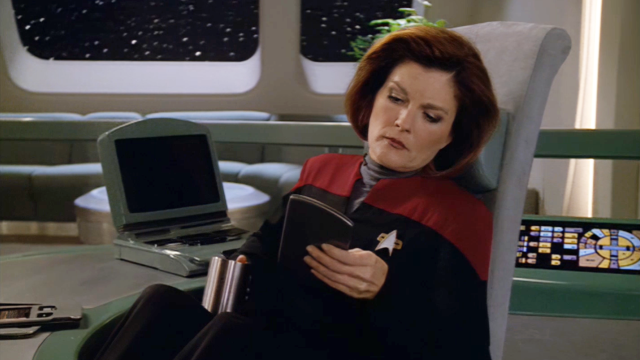Series bibles are a staple of television production. Part early pitch, part worldbuilding exercise, they form the fundamental basis for the earliest concrete visions for a TV show on the road to production. And now you can get a glimpse at the documents behind decades of Star Trek TV, giving access to some truly fascinating behind-the-scenes materials.
The series bibles for TNG, DS9, Voyager, and Enterprise have been floating around the internet in various iterations for a while, but in a new piece by Rob Wieland today, the official Star Trek website provided a fresh look at the foundations of the first four major Star Trek TV continuations. Thanks to these documents, fans can see how these iconic shows were first imagined, what changed on the road to the small screen, and what ideas were the ones writers decided were the most-thought provoking and exciting to sell these shows on to networks.
There’s a lot of interesting contrasts between each show’s documents, not just from the ideation and worldbuilding they contain, but in things like seeing Voyager’s sales pitch alongside its series bible — the document given to press and marketing branches at the time, as part of the series’ major status as a launch show for UPN.
There’s small details about things that changed from the time of writing these bibles to what we got on screen, too — Elizabeth Janeway became Kathryn, Deep Space Nine’s use of the wormhole Gamma Quadrant was originally going to require ships coming to the station to receive special engine modulations to form the “premise of the week,” and T’Pol was originally meant to be a younger T’Pau, the Vulcan logician and diplomat who officiated Spock’s wedding in “Amok Time.”
But interestingly there’s also signs of the ideologies behind each series that you see established, ones that would grow over their respective shows. TNG’s bible, for example, focuses on the role of the Enterprise-D not as a warship, but a vessel for families and researches, showcasing the life aboard the starship beyond the roles of what its Starfleet officers were doing up on the bridge.
DS9‘s darker vision of Trek’s utopia is there from the get-go, as it discusses the ramifications of the Cardassian occupation of Bajor, and Starfleet’s unsettled role in negotiating the aftermath — describing the titular station as being like “a United Nations based located within in the territory of a sovereign nation.”
They all make for fascinating reads if you’ve got the time — as Star Trek draws closer to its 55th anniversary in a few weeks, it’s a nice look back to the things that made it what it was in the first place, as well as glimpses of what could’ve been.

Leave a Reply